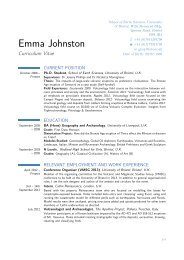What is Scientific Progress?
What is Scientific Progress?
What is Scientific Progress?
You also want an ePaper? Increase the reach of your titles
YUMPU automatically turns print PDFs into web optimized ePapers that Google loves.
are at least now in a position to decide whether science <strong>is</strong> rational and progressive—a<br />
crucial necessity denied to us if we retain the classical connections between progress,<br />
rationality, and truth.” (Laudan 1977, 127)<br />
It <strong>is</strong> th<strong>is</strong> that makes Laudan’s account (and similarly Kuhn’s account) internal<strong>is</strong>t. Whether or not a<br />
scientific community has made progress can be judged and known by that community, and does not<br />
depend on features that may be unknown to them (such as whether their problem <strong>is</strong> genuine and<br />
whether their solution <strong>is</strong> true or known).<br />
But matters are not straightforward for the anti-real<strong>is</strong>t conception of progress. If Oresme can solve<br />
h<strong>is</strong> problem by coming up with a theory from which the splitting of diamonds by hot goat’s blood <strong>is</strong><br />
deducible, then Oresme has thereby contributed to scientific progress, according to Laudan. In fig.<br />
2.2 (a) below the upward diagonal line represents th<strong>is</strong> increase in problem-solving. If Oresme’s<br />
solution <strong>is</strong> sufficiently similar to an appropriate paradigm then it will be a contribution to progress<br />
according to Kuhn’s standards also. While such a solution might reasonably have seemed to<br />
Oresme and h<strong>is</strong> contemporaries to be a contribution to progress it <strong>is</strong> surely m<strong>is</strong>taken to think that<br />
th<strong>is</strong> <strong>is</strong> therefore a contribution to progress. Indeed, given that the solution would involve a<br />
falsehood as much as the problem itself Oresme’s alleged progress adds falsity to falsity.<br />
Furthermore, imagine that some second scholar later comes along and proves at time t by<br />
impeccable means that Oresme’s solution cannot work. Whereas we had a solution before, we now<br />
have no solution. Hence in fig. 2.2 (a) at time t the line dips downward. By Laudan and Kuhn’s<br />
standards that would mark a regress. But the correct thing to say <strong>is</strong> that the later scholar did indeed<br />
contribute to progress in a small way, by giving us knowledge that something previously thought to<br />
be true <strong>is</strong> in fact false. Fig. 2.2 (b) charts the change in knowledge. Fig. 2.3 (c) depicts our intuitions<br />
9






